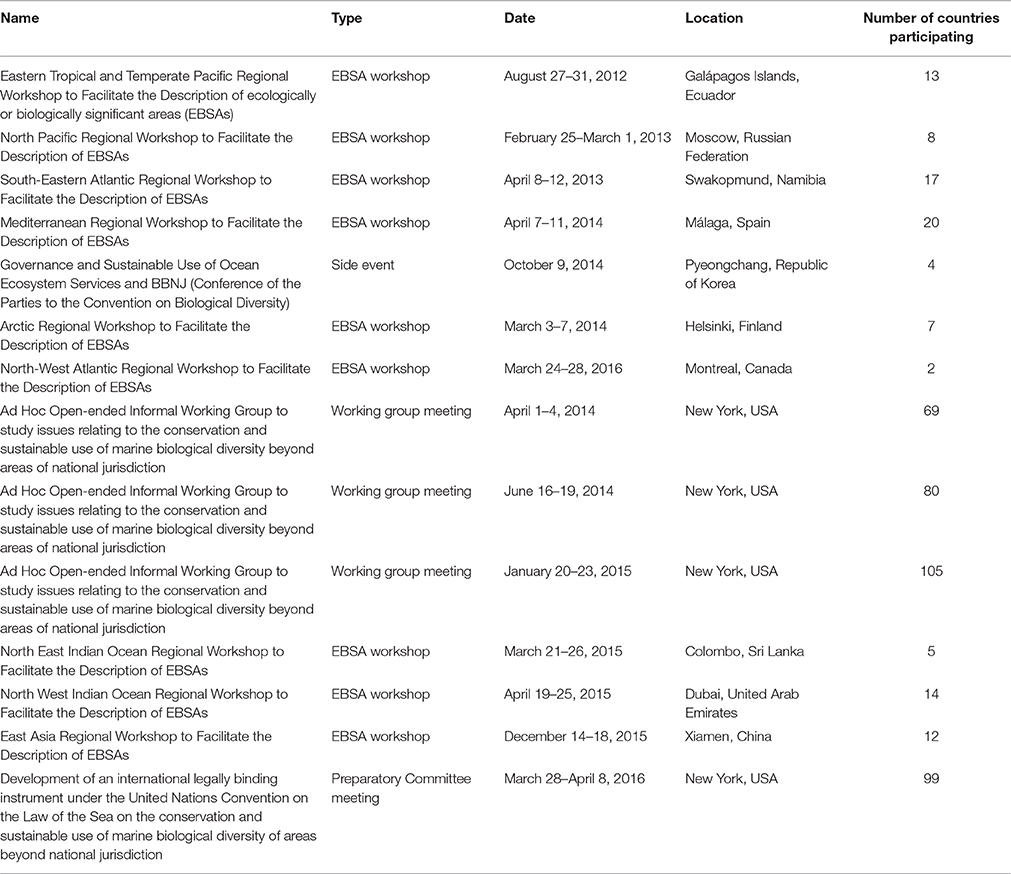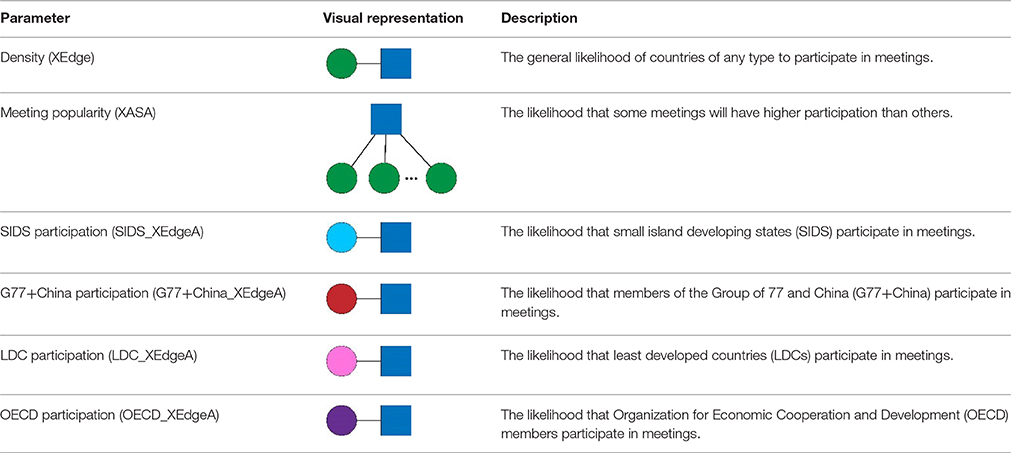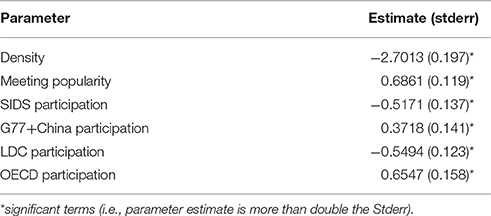- 1Graduate School of Agricultural and Life Sciences, The University of Tokyo, Tokyo, Japan
- 2Institute for the Advanced Study of Sustainability, United Nations University, Tokyo, Japan
- 3Environmental Change and Governance Group, University of Waterloo, Waterloo, ON, Canada
- 4Ocean Alliance, The University of Tokyo, Tokyo, Japan
A relatively small group of states is disproportionately active in marine areas beyond national jurisdiction (ABNJ), raising questions of equity, while a myriad of sectoral regulations and guidelines spread across multiple international bodies has led to uneven conservation and use of biological diversity and resources in these areas. Within this context, the UN General Assembly resolved in 2015 to begin negotiations on an international legally-binding instrument to conserve and protect biodiversity in ABNJ, with the negotiations framed by four issues: (1) marine genetic resources, including questions on the sharing of benefits; (2) measures such as area-based management tools, including marine protected areas; (3) environmental impact assessments; (4) capacity building and the transfer of marine technology. Yet our analysis demonstrates that least developed countries (LDCs) and small island developing states (SIDS) are significantly under-represented in regional and international meetings on such issues, while the authorship of academic literature on these topics is dominated to an unusual extent by Organization for Economic Cooperation and Development (OECD) member states (97%). Statistical analysis of delegation statements delivered during the first round of negotiations following the UN General Assembly resolution also illustrates that the interests of OECD member states differ substantially from LDCs and SIDS, suggesting that imbalanced representation has the potential to result in skewed negotiations. Moreover, the restriction on negotiating parties not to undermine the mandate of existing organizations limits their maneuverability, and may hamper progress toward achieving ambitious time-bound commitments to promote sustainable resource use and reduce inequality (e.g., under the Sustainable Development Goals and Aichi Targets). With ABNJ covering half the world's surface, self-interested compliance with new regulations is the most promising pathway to conservation and sustainable use, yet remains unlikely unless states feel their views, concerns and best interests have been reflected in the negotiated agreement.
Introduction
Marine areas beyond national jurisdiction (ABNJ) cover nearly half the Earth's surface, representing the largest habitat for life on the planet (Druel and Gjerde, 2014; St. John et al., 2016). Historically, anthropogenic impacts on ABNJ were limited due to their inaccessibility (generally beginning 200 nautical miles from coastlines), but recent decades and technological innovations have brought a paradigm shift as States rapidly expand their activities in ABNJ (Merrie et al., 2014). Coupled with the well-documented lack of an overarching framework for conservation and management of biological diversity in beyond areas of national jurisdiction (BBNJ), this trend has drawn increasingly urgent calls for a new implementing agreement on BBNJ under the United Nations Convention on the Law of the Sea (UNCLOS; Dunn et al., 2014; Wright et al., 2016).
Following a decade of working group discussions on BBNJ, the United Nations General Assembly reached consensus in 2015 to enter into negotiations on drafting an international, legally-binding instrument under UNCLOS addressing a “package” of four issues: (1) marine genetic resources, including issues of benefit sharing; (2) area-based management tools, such as marine protected areas (MPAs); (3) environmental impact assessments (EIA); and (4) capacity building and the transfer of marine technology (Wright et al., 2016). States agreed that the new instrument must address all four package issues “together and as a whole” (UNGA, 2015).
The UN General Assembly (UNGA) resolution stipulates that any new agreement must not undermine the mandate of existing organizations (UNGA, 2015). Although such “savings clauses” are common in international law to preserve existing institutions (Burgiel, 2008), this presents a particular challenge within the context of BBNJ, as a patchwork of relevant sectoral regulations and guidelines on conservation and sustainable use is spread across more than a dozen international bodies (Ban et al., 2013). Ideally, however, the development of a BBNJ agreement provides an opportunity to harmonize and enhance existing governance mechanisms (Kim, 2013).
Formal negotiations have provided a context for States to address shared problems and concerns (Kinne, 2013; Lubell, 2013), but discussions around the four package issues have highlighted imbalances in exploitation of resources in ABNJ. For instance, over 70% of patents on genetic sequences of marine provenance are held by three countries (Arnaud-Haond et al., 2011). Likewise, 10 countries generated 70% of the USD 12 billion in landed value from fishing activities in ABNJ from 2000 to 2010 (Sumaila et al., 2015), where some deep-sea fishing has also been causing severe negative environmental impacts (Pusceddu et al., 2014; Clark et al., 2015). Delegation statements delivered in March/April 2016 during the first meeting of the BBNJ Preparatory Committee (BBNJ PrepCom1) demonstrated that many countries see this as an opportunity not only to conserve BBNJ, but to push for more equitable sharing of benefits from human activities in ABNJ. Other delegations, however, consider the management of resources in ABNJ to fall firmly under the purview of existing organizations, and hence beyond the scope of the current negotiations—e.g., fisheries in ABNJ being the responsibility of regional fishery management organizations and arrangements.
The ongoing negotiations therefore have implications that extend well beyond the realm of biodiversity conservation. For example, a shift in legal interpretations regarding the sharing of benefits derived from ABNJ, or through the introduction of new safeguards or precautionary measures on extractive activities, could carry substantial economic repercussions (Arnaud-Haond et al., 2011). Moreover, the connectivity of marine systems means that changes in the management of ABNJ will almost certainly have spillover effects on the Exclusive Economic Zones of sovereign States. Public health in low-income food-deficit countries could be impacted if changes occur in their access to fish, which constitutes a source of micronutrients crucial for early childhood development and long-term health outcomes (Golden et al., 2016). In the Maldives, for instance, fish are a crucial source of the population's micronutrients, particularly highly-migratory tuna stocks, which are in decline (Blasiak et al., 2016). Furthermore, despite commitments under UNCLOS to build capacity and transfer marine technology to developing states, many still lack the means to access resources in ABNJ or benefit from their exploitation, leaving them de facto excluded from a potential source of economic development, and in some cases unable to sustainably and effectively fish within their own jurisdictions (UNCLOS, 1982). Several of the package elements have the potential to influence such dynamics. At the same time, the BBNJ negotiations occupy a seemingly paradoxical space, with a scope that is simultaneously vast (ABNJ cover nearly half the Earth's surface) and highly restricted (four package issues, and no undermining of existing institutions), and coming mere months after the adoption of a set of Sustainable Development Goals (SDGs) calling, among other things, for urgent action to reduce existing inequalities (SDG10) and to “conserve and sustainably use the oceans, seas and marine resources” (SDG 14). Hence, negotiating a substantial agreement accepted by all will require great effort, care, and expertise.
Here we identify imbalances in the capacity of different groups of States to shape the negotiations over the international legally-binding instrument for BBNJ. We were particularly interested in: (1) the extent to which different groups of States are participating in BBNJ negotiations; (2) the scientific capacity available to States and their delegations; (3) the different priorities of States in shaping the BBNJ agreement. The three lines of investigation were designed to potentially tell a larger story, for although a review of past BBNJ negotiations certainly shows that different States and Groups have different priorities (Morgera, 2015), it would point to a fundamental limitation in the ongoing negotiations if the priorities of States that are under-represented and have limited advisory capacity are also substantially different from other groups. First, we use participant lists from regional and international meetings on BBNJ to assess proportionality of representation. This is coupled with an assessment of authorship of peer-reviewed journal articles on BBNJ issues, which reflects the number of BBNJ experts within different countries, and therefore provides a proxy for the advisory capacity available to respective State governments. Using statistical analysis of official statements delivered by delegations at BBNJ PrepCom1, we furthermore demonstrate that States with participatory under-representation and limited technical advisory support have their own distinct concerns and interests. Our results indicate past and present imbalances in the BBNJ negotiation process, suggesting that a new instrument could formalize an inequitable status quo, with associated risks of unequal buy-in and compliance with any new regulations.
Methods
Network Analysis of Meeting Participation
We collected all available participant lists from regional and global meetings specifically focused on BBNJ issues. We included regional meetings in addition to global meetings to limit biases associated with only looking at the global-level (e.g., some countries more likely to participate in regional meetings). This yielded a set of 14 lists for meetings convened from 2012 to 2016 (Table 1). We used the participant lists to construct two-mode networks (Figure 1) consisting of meetings and the focal countries (Lubell et al., 2014; McAllister et al., 2015). The participation of at least one delegate from a particular country in a particular meeting determined the presence of a tie between that country and meeting (McAllister et al., 2014). The countries were coded according to four categories:
(1) Organization for Economic Cooperation and Development (OECD) members;
(2) Members of the Group of 77 + China (G77+China)1;
(3) Least Developed Countries (LDCs)2;
(4) Small Island Developing States (SIDS).
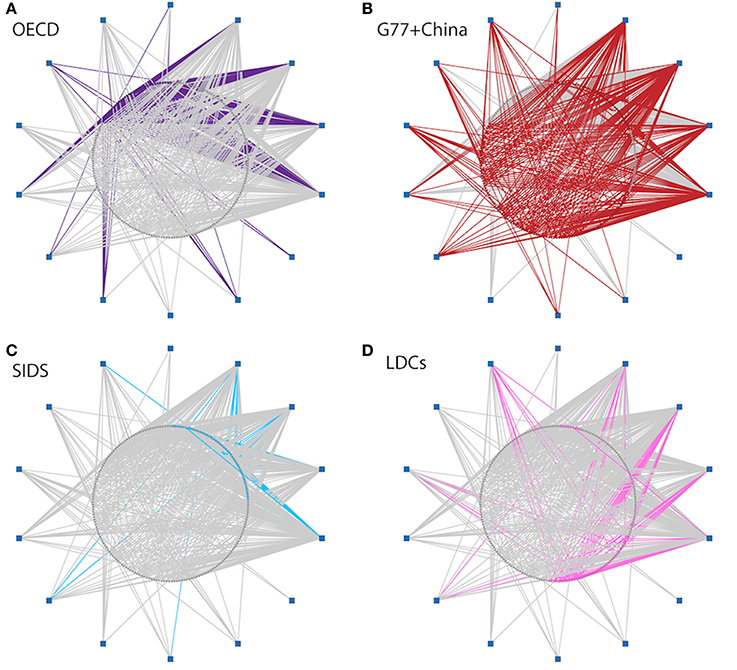
Figure 1. Network diagrams showing countries' (circles) participation in meetings related to biodiversity in areas beyond national jurisdiction (squares). The diagrams are colored to highlight participation by (A) Organization for Economic Cooperation and Development (OECD) members, (B) Group of 77 + China members (G77+China), (C) small island developing states (SIDS), and (D) least developed countries (LDCs). [Note, there are 34 OECD members, 134 G77+China members, 52 SIDS, and 48 LDCs].
We then analyzed the resulting network using Exponential Random Graph Modeling (ERGM), which tests the propensity of certain sets of ties in the network against their propensity in a set of random networks (Lusher et al., 2013; Guerrero et al., 2015). The sets of ties are treated as parameters in the model, which also accounts for the potential nestedness of the sets (i.e., sets contained within other sets). Our parameters of interest were chosen to capture the extent to which the different groups of countries were participating in the BBNJ meetings (Table 2). We included two control parameters in the model. First, we control for the fact that some meetings are regionally focused (i.e., not all countries invited) by including a parameter capturing participation by countries of any type in the meetings (density). Second, we control for the likelihood of higher participation in the globally focused meetings by including a parameter that accounts for some meetings being attended by relatively more countries (meeting popularity). These two control parameters help account for differences in the potential scope of attendance at the various meetings.
Parameters significantly driving network formation are those whose estimates are twice their standard error (Lusher et al., 2013). Positive (negative) estimates suggest the parameter is more (less) important in driving the network than expected by chance. We undertook a standard goodness of fit procedure for ERGMs (see Lusher et al., 2013), and our model was able to reproduce reasonably well all sets of ties included in the model and others not included (e.g., 2-Star configurations including country-type attributes). We also built a model for comparative purposes that contained all the same sets of ties as parameters, except we fixed the density of country-meeting ties instead of including the density control parameter noted above. We found no significant difference between the output from the two models. We used MPNet software to undertake the modeling (Wang et al., 2009).
Assessment of Peer-Reviewed Literature
We created a catalog of peer-reviewed articles dealing with BBNJ issues by searching3 the Thomson Reuters Web of Science database and individual marine science journals, yielding a group of 59 articles authored by 212 individuals based at 106 institutions or organizations. We furthermore found that over 86% of these articles were from just four journals (Marine Policy, The International Journal of Marine and Coastal Law, Ocean Yearbook, and Ocean and Coastal Management), and to enable comparative analysis, created a proxy set of marine science articles on all topics, by collecting all articles from the January 2016 issues of these four journals. This yielded a group of 75 articles by 230 authors based at 167 institutions or organizations. We used the two groups of articles to then assess geographical contribution to shaping the literature on BBNJ issues, and relative differences vis-à-vis the proxy group of marine science articles on all topics. We further classified authors in both categories by matching their affiliations with the same country groups used in the network analysis.
Data Mining of Delegation Statements
We collected official statements provided to the UN Division for Ocean Affairs and Law of the Sea (UNDOALOS) Secretariat by State delegations and Groups over the course of BBNJ PrepCom1 (28 March–8 April 2016). To assess these 115 documents, we wrote a text mining script4 using the R statistical software to generate heatmaps and dendrograms of the respective frequency with which delegations raised one of the four package elements or other indicative words or phrases selected by the authors. In addition, we considered both overall frequency as well as weighted frequency per 1000 words of text, and assessed States both individually and in aggregate categories (OECD, G77+China, LDCs, SIDS).
Finally, we used the weighted frequencies derived from the text mining to run Pearson product-moment correlations against per capita gross national income (GNI) and indicators of State governance to determine whether a focus on specific package issues is associated with States' economic well-being or regulatory capacity (Kaufmann and Kraay, 2015; UNDP, 2015). To enable the inclusion of statements made by groups, namely the Caribbean Community (CARICOM), G77+China, and Pacific Small Island Developing States (PSIDS), we averaged the per capita GNI and governance capacity of all individual members in each respective group.
Results
Network Processes
The ERGM results indicate that both SIDS and LDCs are participating in the meetings less than expected by chance, while OECD members and G77+China are participating more (Table 3). There are many LDCs with considerably less participation than other countries (Figure 2A), while the same is true for SIDS (Figure 2B). Only 63 and 52% of LDCs and SIDS, respectively, have attended at least one meeting; while 75 and 94% of G77+China and OECD members have done so. However, ~12 and 45% of G77+China and OECD members have attended five or more meetings, compared with only 2% of SIDS, and no LDCs.
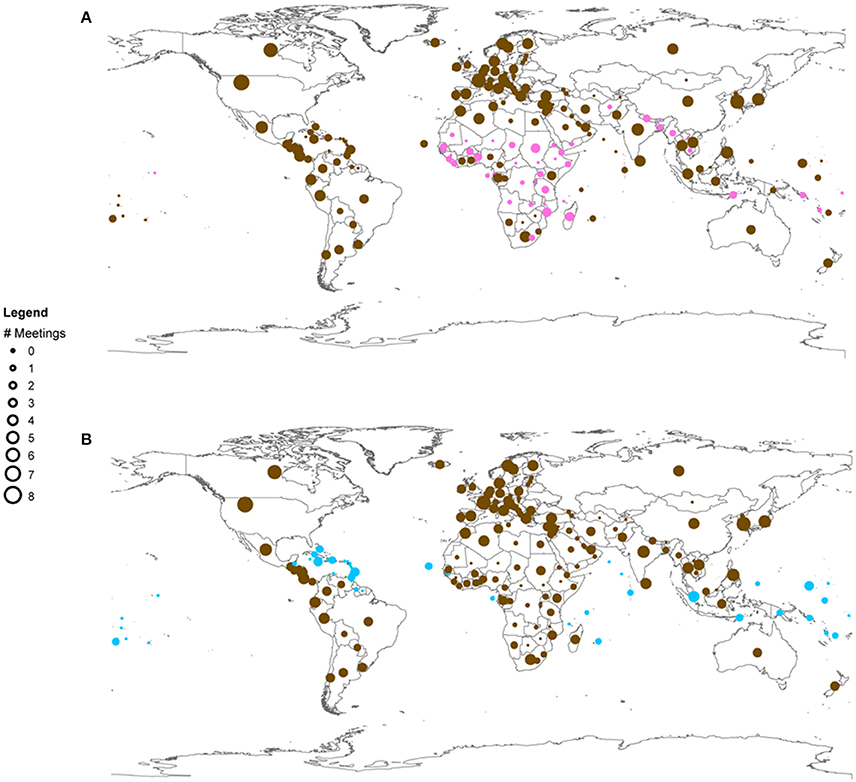
Figure 2. Mapping of countries' participation in meetings related to biodiversity in areas beyond national jurisdiction. (A) Least developed countries highlighted in pink; (B) Small island developing states highlighted in blue. The size of the circle corresponds to the number of meetings in which each country participated.
In addition, participant lists suggest considerable variation in the continuity of expertise within delegations. Looking at the four most recent UN-level meetings on BBNJ from 2014 to 2016 (see Table 1), many OECD countries (42.9%) had at least one delegation member who attended all of the meetings, more than four times the level for the G77+China (10.4%). Even lower rates of delegation continuity were evident for SIDS (7.7%) and LDCs (4.2%).
Scientific Discourse
The peer-reviewed literature on marine issues is primarily produced by authors based in OECD member states (79%), but this tendency is far stronger for articles on BBNJ issues (98%). We found that authors from five OECD states accounted for over 70% of the authorship of BBNJ articles, while 163 countries were not represented (Figure 3). A negative correlation (R = −0.87, p < 0.001) exists between the number of authors from each country in the sample and the percentage of countries with a given number of authors (Figure 3, inset). Within the proxy sample of marine science articles on all subjects, 21% of authors had affiliations in non-OECD states, while this figure was 2% for BBNJ articles, with no authors based in SIDS or LDCs.
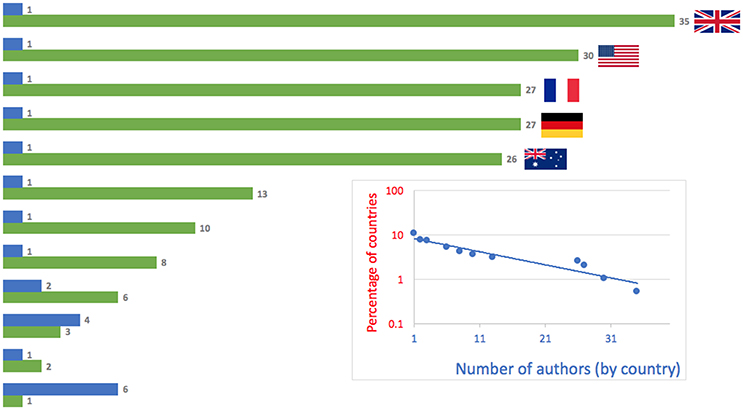
Figure 3. Number of authors (green bars) of peer-reviewed articles on biodiversity in areas beyond national jurisdiction (BBNJ), and number of countries home to this number of authors (blue bars). Inset shows the logarithmic correlation between the number of authors with affiliations in each country and the percentage of countries with that number of authors. One hundred and sixty three countries were not represented by any authors in the BBNJ literature.
Statements and Interests
Delegations to BBNJ PrepCom1 demonstrated divergent levels of interest in individual elements of the BBNJ package. Marine genetic resources were the primary focus of SIDS, a trend that was even more pronounced for LDCs (Figure 4A); while OECD states more frequently mentioned MPAs and EIAs. Capacity building was not the primary focus of any of the groups. A heatmap of individual statements mirrors these findings, and the associated dendrogram reflects the clustering of focus on MPAs and EIAs, as well as the relatively distinct focus on MGRs (Figure 5). The heatmap also identified clusters of States and Groups with high interest in MGRs (Federated States of Micronesia, Jamaica, Papua New Guinea), and those with a heavy focus on MPAs and EIAs (USA, European Union, CARICOM), while capacity building does not emerge as a clear priority for any clusters. Furthermore, state governance capacity as well as per capita GNI are positively correlated with the frequency of references to MPAs (R = 0.52, p < 0.05; R = 0.50, p < 0.05 respectively), but not the other package issues.

Figure 4. Weighted frequency with which states and groups made reference to (A) the four elements of the package; (B) other indicative keywords.
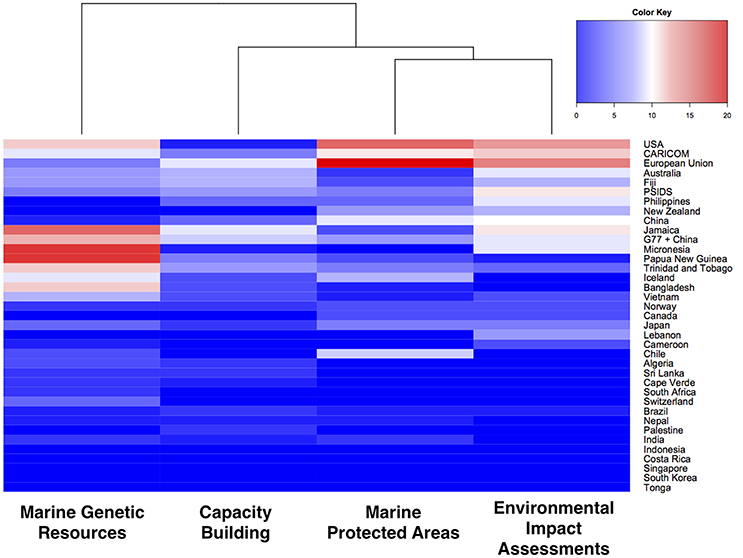
Figure 5. Overall frequency with which package elements were identified by States and Groups in official statements during first meeting of the preparatory committee on biodiversity in areas beyond national jurisdiction, with overarching cluster analysis.
Several terms or phrases were identified during the text mining as proxies of broader attitudes based on the authors' experiences attending the BBNJ PrepCom1. These included “undermine,” due to the General Assembly Resolution that any new agreement not undermine existing agreements, “common heritage of mankind,” due to the importance of this legal concept to the management of seabed resources and potentially MGRs, and “opportunity” as a proxy for State attitudes about the potential of these negotiations. A weighted frequency analysis found OECD members nearly twice as likely to mention the danger of undermining existing agreements than their SIDS and LDC counterparts, with several States particularly reluctant to alter existing mandates on straddling and highly migratory fish stocks under the UN Fish Stocks Agreement (Wright et al., 2016). The inverse relationship was found for “opportunity” (Figure 4B). An even starker contrast was identified for the phrase “common heritage of mankind,” which was more than five times as likely to be used by LDCs than OECD states.
Discussion
The success of any new BBNJ instrument under UNCLOS will crucially depend on buy-in by all states. Compliance gaps within UNCLOS and UNFSA highlight the challenge of effectively monitoring and enforcing regulations in vast ocean areas, where illicit activities are sometimes simply displaced into areas with weaker governance (Österblom, 2014; Blasiak, 2015; Blasiak and Yagi, 2016). Therefore, although the findings of this study may be most immediately relevant for delegations from SIDS and LDCs, they are also important for the highly industrialized states with their deep pools of legal and scientific expertise. Nowhere is self-interested compliance by states as crucial as in the vast ABNJ, and negotiating a BBNJ instrument accepted by all and fundamentally representative of the interests of all is the most promising pathway to such an outcome.
Self-interested compliance also depends on States having sufficient capacity to conduct their monitoring and regulatory responsibilities effectively. Yet a notable finding of our analysis is that among the four BBNJ package elements, capacity building and the transfer of marine technology seems to be a relatively low priority, a trend evident for both the OECD and G77+China, as well as the sub-categories of SIDS and LDCs. Despite numerous calls for capacity building, and international commitments to engage in such activities, it remains the least implemented part of UNCLOS (UNGA, 2014). One possibility is that the failure of states to meet past commitments to capacity building may have caused SIDS and LDCs to dedicate less energy to negotiating this package element.
In a strategic sense, however, States are certainly considering both the short-term and long-term obligations and benefits associated with each of the package elements. Broadly, the first two package elements—MGRs, and area-based management tools such as MPAs—are associated with subjective ideals of participating States with regard to the value and ethics of conservation, sharing of benefits, and the scope of marine resources considered under the common heritage of mankind. All of these issues are hotly debated and this research takes no specific position on them, yet analysis of delegation statements shows the greatest divergence across the OECD/SIDS/LDCs for these two package elements, suggesting that finding consensus on them will pose the greatest hurdle to realizing the new BBNJ instrument (Wright et al., 2016). Moreover, regardless of how the benefits from the exploitation of MGRs are shared, their economic value is unclear and monetary benefits likely lie far in the future. Any perceived economic loss associated with the establishment of MPAs, however, would be immediate, suggesting that compensatory tradeoffs between the two package elements to build consensus on an implementing agreement would face a mismatch in timeframes. The latter two package elements—EIAs and capacity building and transfer of marine technology—have a less subjective and more practical character. The likelihood that industry actors will face new obligations with regard to EIAs, however, raises some questions due to their virtual absence during the first BBNJ PrepCom meeting. If the BBNJ process follows a similar pattern to previous environmental negotiations, such as the Cartagena Protocol on Biosafety, it can also be expected that industry representatives will become a larger and stronger presence in future meetings (CBD, 2000; Burgiel, 2008). As previously stated, a lasting and durable new implementing agreement will depend on capacity building, which would be both a long-term obligation for some states, while only providing tangible benefits over the long term to others. The limited focus on capacity building in the first round of negotiations suggests that delegations may be strategically focusing on those package issues with the potential to generate tangible economic benefits or obligations over the short to medium term.
Our analysis also suggests that LDCs and SIDS are entering into the negotiation of an international, legally-binding instrument on BBNJ at a considerable disadvantage vis-à-vis OECD states, many of which are among those most active in ABNJ today. The absence of authors based in LDCs and SIDS in the peer-reviewed literature, for instance, points not only to a lack of domestic scientific capacity to advise delegations or governments, but also suggests that the body of scientific literature on BBNJ could potentially be skewed toward the particular interests of a small group of states. This is compounded by demonstrated imbalances in participation by LDCs and SIDS in regional and international meetings, and the comparatively low level of continuity in their delegations.
We acknowledge, however, that participation in meetings does not necessarily correlate with influence, just as having a large body of domestic expertise on BBNJ issues does not mean that governments can or would draw on this expertise (Corell and Betsill, 2008). Moreover, the influence of private sector or civil society actors on different national governments certainly varies among countries, and changes over time. For instance, developing countries have been particularly reliant on advisory support from NGOs in past international negotiations on environmental issues (Burgiel, 2008). Such considerations, however, are beyond the scope of our study, which considers representational imbalances that are frequently stated, yet seldom quantified.
Efforts have been made to promote the participation of SIDS and LDCs in the BBNJ negotiations, including through a voluntary trust fund to support the attendance of “developing countries, in particular [LDCs], landlocked developing countries and [SIDS]” (UNGA, 2015). Such efforts are in line with global commitments, including SDG 10 to “ensure enhanced representation and voice for developing countries” (UN, 2015). Despite these possibilities, our analysis shows that the governments of both developing and OECD states will need to take further steps to ensure that future meetings and negotiations are founded on conditions of representativeness and equity. Moreover, the insertion of a savings clause into the United Nations General Assembly resolution on the establishment of the BBNJ Preparatory Committee and future steps toward creating a new international legally-binding instrument specifically bars States from undermining the mandate of existing organizations. This simultaneously “saves” the existing framework for the use of natural resources, while eliminating the opportunity for negotiating States to substantially alter the status quo of resource use in ABNJ. The tendency to use such savings clauses in international law also suggests a considerable barrier to enacting fundamental changes, and perhaps a point of enduring tension with commitments like SDG 10 for a fundamentally more equal world, both in ABNJ and elsewhere.
Author Contributions
RB, JP, NY, and HS all contributed to designing and conducting the research. RB led the research and drafted the manuscript. JP conducted network analysis and drafted portions of manuscript. HS created R script for data mining.
Conflict of Interest Statement
The authors declare that the research was conducted in the absence of any commercial or financial relationships that could be construed as a potential conflict of interest.
Acknowledgments
We would like to thank Henrik Österblom for particularly fruitful comments on an early draft, as well as the three reviewers for their constructive and helpful suggestions. This research was supported by Japan Society for the Promotion of Science KAKENHI grants (projects 24121010 and 16K18743) as well as Ocean Alliance project “Science on Consensus Building Methods Related to Ocean Use” (with financial support from the Nippon Foundation). JP was supported by a Social Science and Humanities Research Council Joseph-Armand Bombardier Canada Graduate Scholarship Doctoral Award and an Ontario Graduate Scholarship award.
Supplementary Material
The Supplementary Material for this article can be found online at: http://journal.frontiersin.org/article/10.3389/fmars.2016.00224/full#supplementary-material
Footnotes
1. ^When established in 1964, the Group of 77 did include 77 countries, but that number has since increased to encompass a highly diverse range of 134 States, including all SIDS and LDCs, which are also considered as sub-categories within this analysis.
2. ^All States meeting the three criteria defined by the UN Economic and Social Council (ECOSOC) Committee for Development Policy (ECOSOC, 2015).
3. ^Search keywords: ABNJ; BBNJ; areas beyond national jurisdiction.
4. ^Available in supplementary materials.
References
Arnaud-Haond, S., Arrieta, J. M., and Duarte, C. M. (2011). Marine biodiversity and gene patents. Science 331, 1521–1522. doi: 10.1126/science.1200783
Ban, N. C., Bax, N. J., Gjerde, K. M., Devillers, R., Dunn, D. C., Dunstan, P. K., Hobday, A. J., et al. (2013). Systematic conservation planning: a better recipe for managing the high seas for biodiversity conservation and sustainable use. Conserv. Lett. 7, 41–54. doi: 10.1111/conl.12010
Blasiak, R. (2015). Balloon effects reshaping global fisheries. Mar. Policy 57, 18–20. doi: 10.1016/j.marpol.2015.03.013
Blasiak, R., Pacheco, E. J., Furuya, K., Golden, C. D., Jauharee, A. R., Natori, Y., Saito, H., et al. (2016). Local and regional experiences with assessing and fostering ocean health. Mar. Policy 71, 54–59. doi: 10.1016/j.marpol.2016.05.011
Blasiak, R., and Yagi, N. (2016). Shaping an international agreement on marine biodiversity beyond areas of national jurisdiction: lessons from high seas fisheries. Mar. Policy 71, 210–216. doi: 10.1016/j.marpol.2016.06.004
Burgiel, S. W. (2008). “Non-state actors and the cartagena protocol on biosafety,” in Ngo Diplomacy: The Influence of Nongovernmental Organizations in International Environmental Negotiations, eds M. M. Betsill and E. Corell (Cambridge, MA: MIT Press), 67–100.
Clark, M. R., Althaus, F., Schlachter, T. A., Williams, A., Bowden, D. A., and Rowden, A. A. (2015). The impacts of deep-sea fisheries on benthic communities: a review. ICES J. Mar. Sci. 73(suppl 1): i51–i69. doi: 10.1093/icesjms/fsv123
Convention on Biological Diversity (CBD) (2000). Cartagena protocol on biosafety to the Convention on Biological Diversity. Montreal 30.
Corell, E., and Betsill, M. M. (2008). “Analytical framework: Assessing the influence of NGO diplomats,” in Ngo Diplomacy: The Influence of Nongovernmental Organizations in International Environmental Negotiations, eds M.M. Betsill and E. Corell (Cambridge, MA: MIT Press), 19–42.
Druel, E., and Gjerde, K. M. (2014). Sustaining marine life beyond boundaries: options for an implementing agreement for marine biodiversity beyond national jurisdiction under the United Nations Convention on the Law of the Sea. Mar. Policy 49, 90–97. doi: 10.1016/j.marpol.2013.11.023
Dunn, D. C., Ardron, J., Bax, N., Bernal, P., Cleary, J., Cresswell, I., et al. (2014). The convention on biological diversity's ecologically or biologically significant areas: origins, development, and current status. Mar. Policy 49, 137–145. doi: 10.1016/j.marpol.2013.12.002
Economic Social Council of the United Nations (ECOSOC) (2015). Committee for Development Policy Report on the Seventeenth Session. United Nations Official Records E/2015/33.
Golden, C. D., Allison, E. H., Chueng, W. W. L., Dey, M. M., Halpern, B. S., McCauley, D. J., et al. (2016). Fall in fish catch threatens human health. Nature 534, 317–320. doi: 10.1038/534317a
Guerrero, A. M., McAllister, R. R. J., and Wilson, K. A. (2015). Achieving cross-scale collaboration for large scale conservation initiatives. Conserv. Lett. 8, 107–117. doi: 10.1111/conl.12112
Kaufmann, D., and Kraay, A. (2015). World Governance Indicators. Washington, DC: The World Bank Group.
Kim, R. E. (2013). The emergent network structure of the multilateral environmental agreement system. Global Environ. Change 23, 980–991. doi: 10.1016/j.gloenvcha.2013.07.006
Kinne, B. J. (2013). Network dynamics and the evolution of international cooperation. Am. Pol. Sci. Rev. 107, 766–785. doi: 10.1017/S0003055413000440
Lubell, M. (2013). Governing institutional complexity: the ecology of games framework. Policy Stud. J. 41, 537–559. doi: 10.1111/psj.12028
Lubell, M., Robins, G., and Wang, P. (2014). Network structure and institutional complexity in an ecology of water management games. Ecol. Soc. 19:23. doi: 10.5751/ES-06880-190423
Lusher, D. J., Koskinen, J., and Robins, G. (Eds.) (2013). Exponential random graph modeling for social networks: Theory, methods, and applications. New York, NY: Cambridge University Press.
McAllister, R. R. J., McCrea, R., and Lubell, M. (2014). Policy networks, stakeholder interactions and climate adaptation in the region of South East Queensland, Australia. Reg. Environ. Change 14, 527–239. doi: 10.1007/s10113-013-0489-4
McAllister, R. R. J., Taylor, B. M., and Harman, B. P. (2015). Partnership networks for urban development: how structure is shaped by risk. Policy Stud. J. 43, 379–398. doi: 10.1111/psj.12103
Merrie, A., Dunn, D. C., Metian, M., Boustany, A. M., Takei, Y., Elferink, A. O., et al. (2014). An ocean of surprises – Trends in human use, unexpected dynamics and governance challenges in areas beyond national jurisdiction. Global Environ. Change 27, 19–31. doi: 10.1016/j.gloenvcha.2014.04.012
Morgera, E. (2015). Do We Need a New Treaty to Protect Biodiversity in the Deep Seas? IISD Reporting Series Policy Update No. 8.
Österblom, H. (2014). Catching up on fisheries crime. Conserv. Biol. 28, 877–879. doi: 10.1111/cobi.12229
Pusceddu, A., Bianchelli, S., Martín, J., Puig, P., Palanques, A., Masqué, P., et al. (2014). Chronic and intensive bottom trawling impairs deep-sea biodiversity and ecosystem functioning. Proc. Natl. Acad. Sci. U.S.A. 111, 8861–8866. doi: 10.1073/pnas.1405454111
St. John, M. A., Borja, A., Chust, G., Heath, M., Grigorov, I., Mariani, P., et al. (2016). A dark hole in our understanding of marine ecosystems and their services: perspectives from the mesopelagic community. Front. Mar. Sci. 3:31. doi: 10.3389/fmars.2016.00031
Sumaila, U. R., Lam, V. W. Y., Miller, D. D., Teh, L., Watson, R., Zeller, D., et al. (2015). Winners and losers in a world where the high seas is closed to fishing. Scientific Rep. 5:8481. doi: 10.1038/srep08481
United Nations (UN) (2015). Transforming Our World: The 2030 Agenda for Sustainable Development. New York, NY: United Nations.
United Nations Convention on the Law of the Sea (UNCLOS) (1982). Montego Bay, 10 December 1982 (entered into force 16 November 1994), 1833 United Nations Treaty Series (UNTS) 3.
UNDP (2015). Human Development Report 2015: Work for Human Development. New York, NY: United Nations.
United Nations General Assembly (UNGA) (2014). Document A/69/177. Letter dated 25 July 2014 from the Co-Chairs of the Ad Hoc Open-ended Informal Working Group to the President of the General Assembly.
United Nations General Assembly (UNGA) (2015). Resolution 69/292. Development of an international legally binding instrument under the United Nations Convention on the Law of the Sea on the conservation and sustainable use of marine biological diversity of areas beyond national jurisdiction.
Keywords: ABNJ, BBNJ, governance, high seas, least developed countries, marine biodiversity, network analysis, small island developing states
Citation: Blasiak R, Pittman J, Yagi N and Sugino H (2016) Negotiating the Use of Biodiversity in Marine Areas beyond National Jurisdiction. Front. Mar. Sci. 3:224. doi: 10.3389/fmars.2016.00224
Received: 22 July 2016; Accepted: 27 October 2016;
Published: 11 November 2016.
Edited by:
Lyne Morissette, M-Expertise Marine, CanadaReviewed by:
Ricardo Serrão Santos, University of the Azores, PortugalTimo M. Koivurova, University of Lapland, Finland
Angel Borja, AZTI, Spain
Copyright © 2016 Blasiak, Pittman, Yagi and Sugino. This is an open-access article distributed under the terms of the Creative Commons Attribution License (CC BY). The use, distribution or reproduction in other forums is permitted, provided the original author(s) or licensor are credited and that the original publication in this journal is cited, in accordance with accepted academic practice. No use, distribution or reproduction is permitted which does not comply with these terms.
*Correspondence: Robert Blasiak, YS1yYkBtYWlsLmVjYy51LXRva3lvLmFjLmpw
 Robert Blasiak
Robert Blasiak Jeremy Pittman
Jeremy Pittman Nobuyuki Yagi1
Nobuyuki Yagi1